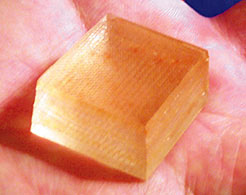A prototype high-density microfluidic optical switch
Jason S. Kuo, Paolo Spicar-Mihalic, Indalesio Rodriguez, and Daniel T. Chiu*
Dept of Chemistry, University of Washington,
Seattle WA 98195-1700 USA
This is an abstract
for a presentation given at the
Ninth
Foresight Conference on Molecular Nanotechnology.
There will be a link from here to the full article when it is
available on the web.
A prototype high-density optical switch using microfluidic movement to bend the light beam path has been developed. The switch consists of a three-dimensional network of micron-size channels molded out of polydimethylsiloxane (PDMS) polymer from a silicon master produced with conventional photolithography. The channels are then filled with two immiscible fluids of different index of refraction. By controlling the location of fluids using either electrowetting or photo-responsive surface wetting techniques, we can selectively transmit or refract the incoming light beam. Electrowetting technique involves altering the contact angle of a fluid with electric field. With electrodes shaped and placed strategically, it is possible to propel a droplet along a microchannel at high velocity. We have developed a method to rapidly (15 minutes) and reproducibly deposit micron-size silver electrodes with electroless solutions for this purpose. Although electrowetting is relatively simple to incorporate as the switching mechanism, the operating voltage, which is a strong function of the dielectric material on top of the electrodes, may be too high (up to few hundred volts) for commercial application. Photo-responsive surface wetting technique involves patterning the surface with azobenzene chromophores, which changes between cis- and trans- isomerization when subjected to UV light. The cis- and trans- isomers have different molecular orientation and dipole moment, and the resulting surface may exhibit preferential hydrophobicity/hydrophilicity toward one fluid. As our first attempt, we have chosen to use 4-octyl-4’(5-carboxypentamethyleneoxy)-Azobenzene as the chromophore, which can be coupled to an amine-terminated surface and form a monolayer. When both immiscible fluids are present in a channel, their relative positions can be switched simply by changing the surface-wetting characteristic, which can be toggled by an UV photon beam. Our multidimensional microfabrication capability allows us to integrate high optical port density within a small volume by building multilayer structures. In addition, with the PDMS molding technique, we can produce prototypes rapidly at low cost. The theory of operation and the results from two fluidic movement methods will be presented.

*Corresponding Address:
Daniel T. Chiu
Dept of Chemistry, University of Washington
Box 351700, Univ of WA, Seattle WA 98195-1700 USA
phone: (206)543-1655
fax: (206)685-8665
email: [email protected]
|